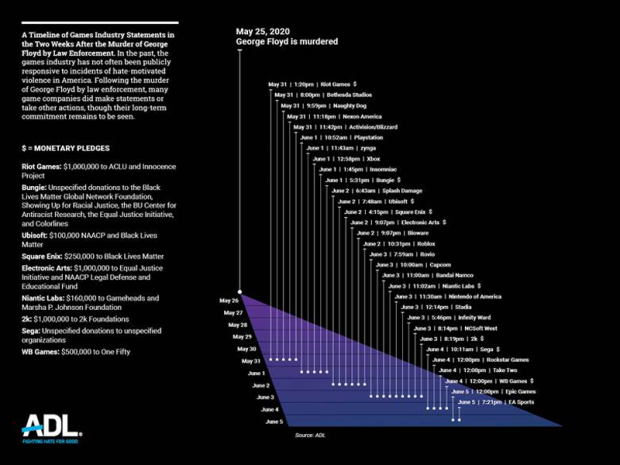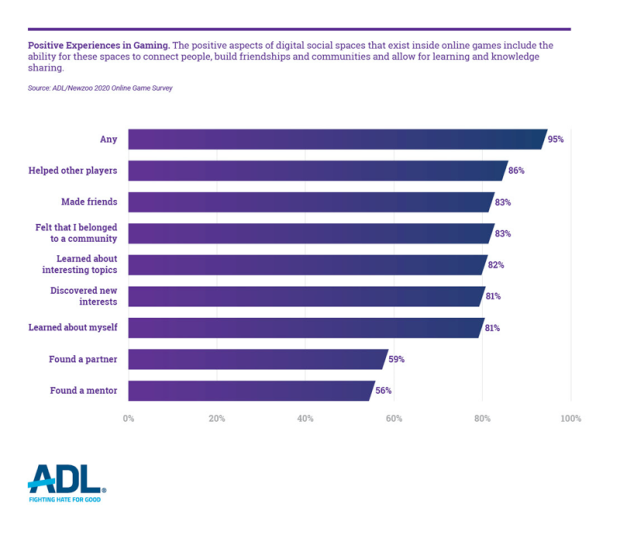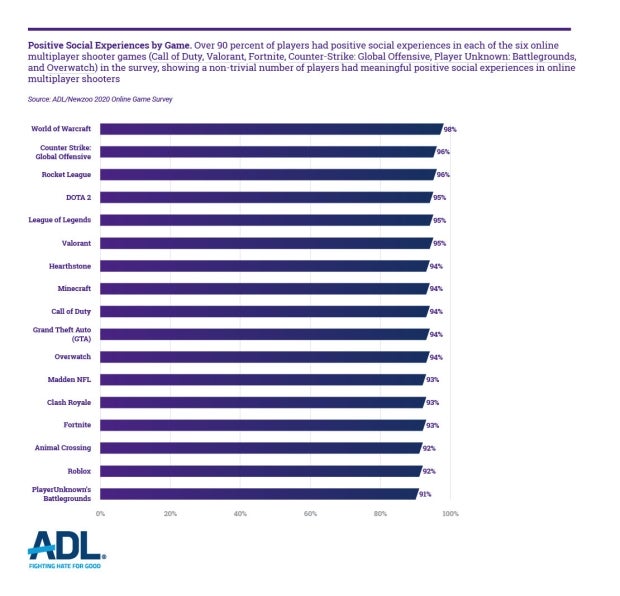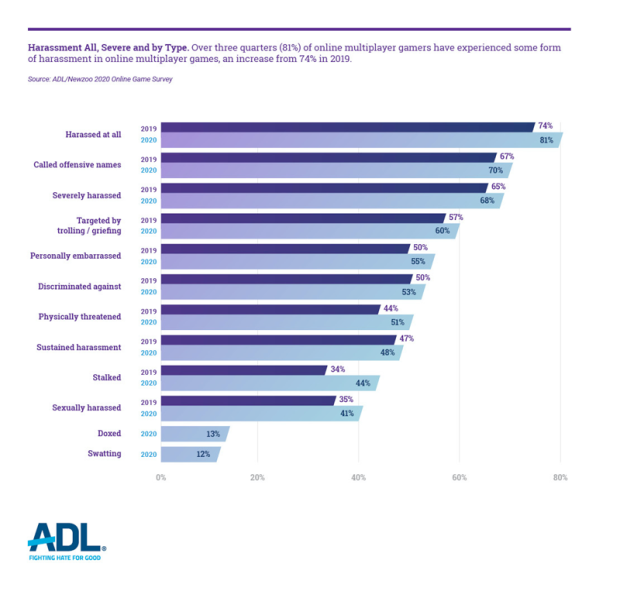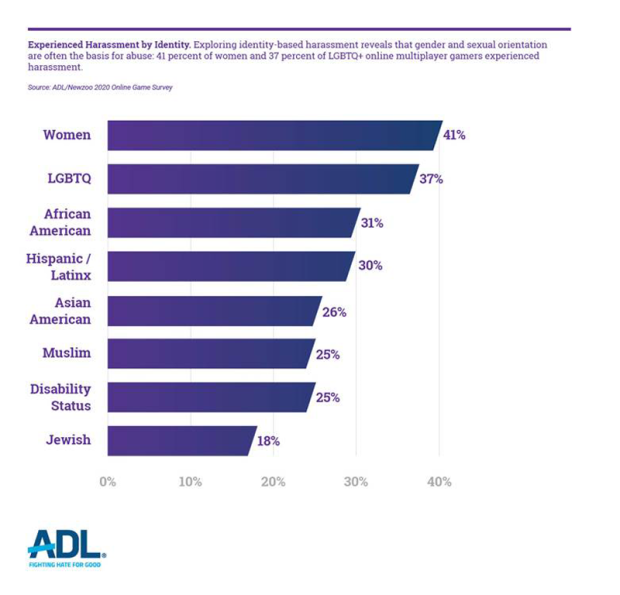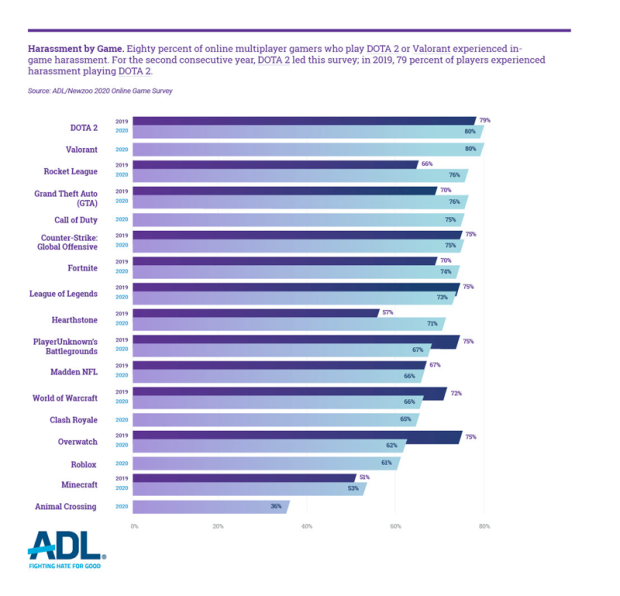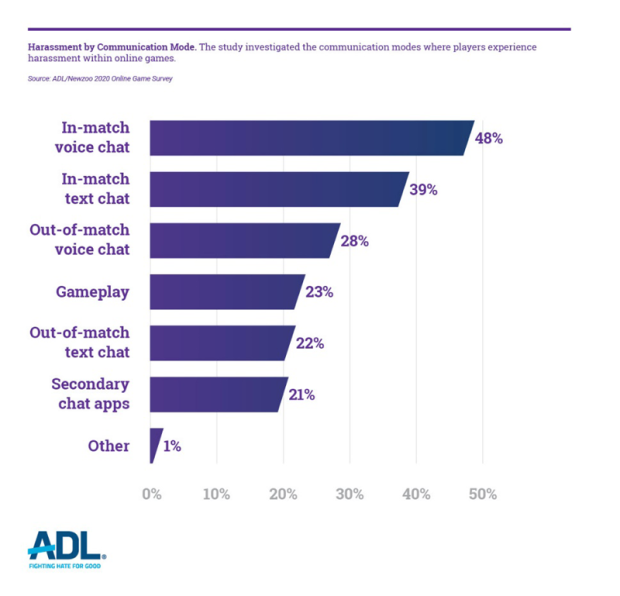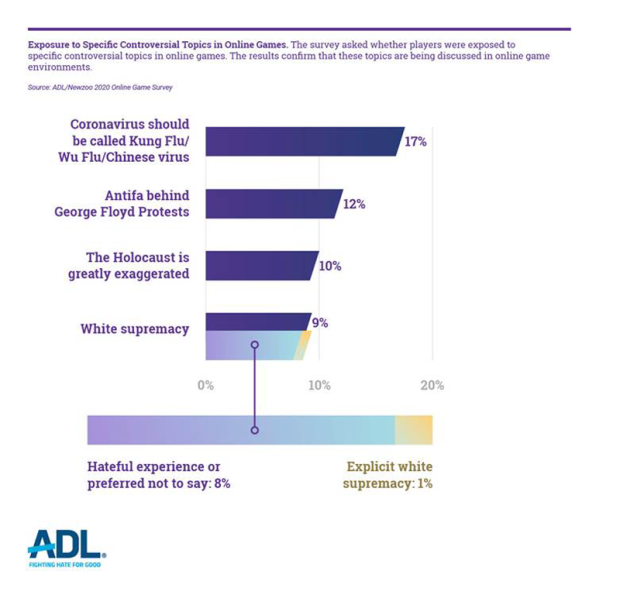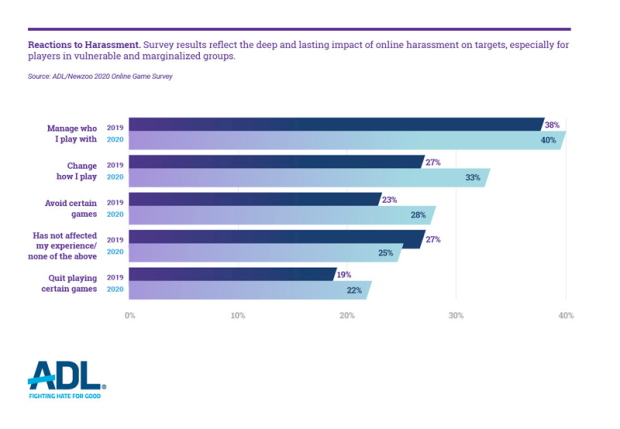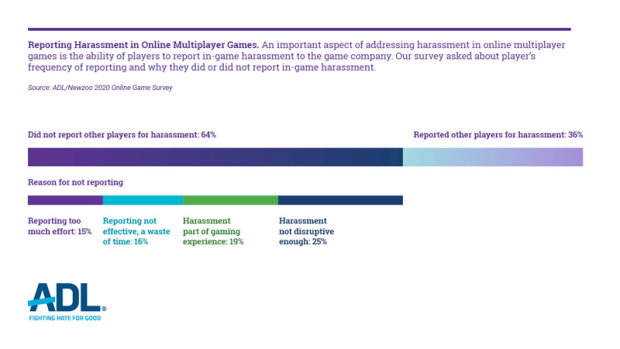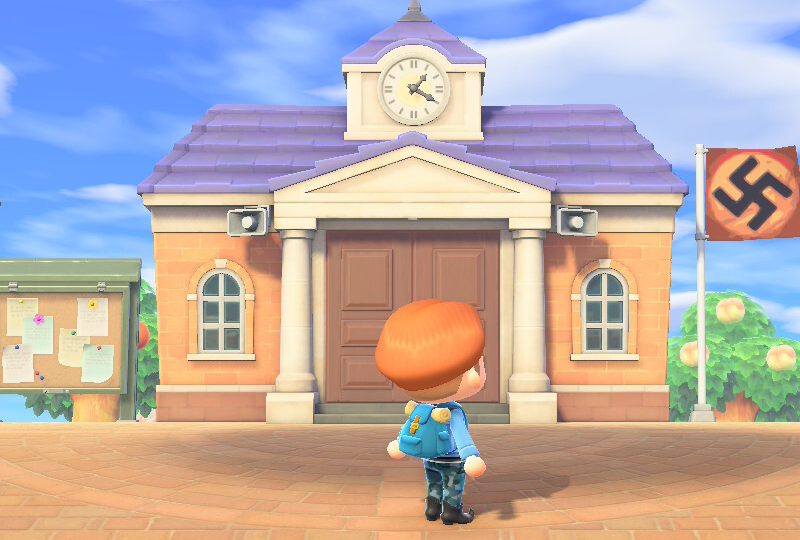
Free to Play? Hate, Harassment and Positive Social Experiences in Online Games 2020
Executive Summary
Video games have been popular in the United States for at least three decades, but the lockdowns and quarantines brought on by the COVID-19 pandemic kicked their growth as vital social spaces into overdrive.1 [i] Over 200 million people, 64 percent of American adults, regularly play video games- which include both online and offline games.[ii] A $159 billion industry, annual revenue from video games increased 9.3 percent this year, whereas revenue reported by traditional media such as movies and music steeply declined.[iii]
Like other social platforms, interactions within video games can be personally enriching and harmful for users. ADL’s survey explored the social interactions, experiences, attitudes and behaviors of online multiplayer gamers across America.
We analyzed findings from a nationally representative survey of American gamers aged 18-45 designed by ADL’s Center for Technology and Society in collaboration with Newzoo, a data analytics firm focused on games and esports. ADL previously worked with Newzoo to produce the first “Free to Play? Hate, Harassment, and Positive Social Experiences in Online Games” survey in 2019. This year’s report used a similar methodology, which allowed for a year-over-year comparison in some areas. In other areas, however, we refined the current study’s methodology to provide more accurate data, but as a result we cannot allow for a direct comparison between 2019 and 2020.
Our 2020 survey found that 95 percent of adults aged 18-45 who played online multiplayer games in the U.S. had positive social experiences while playing. They helped other players (86%), made friends (83%), and felt they belonged to a community (83%). Games cited by players as producing the most positive social experiences were World of Warcraft (98%), Rocket League (96%), Defense of the Ancients 2 (DOTA 2) (95% of players of that game), League of Legends (95%), Valorant (95%).
Despite that positive news, ADL’s survey also found high levels of harassment in online multiplayer games and showed a year-over-year increase in harassment. For 2020, 81 percent of U.S. adults aged 18-45 who played online multiplayer games experienced some form of harassment, an increase from the figure of 74 percent reported in the 2019 survey. Thirty six percent of online multiplayer gamers who experienced harassment reported that it did not impact their play at all. That still translates to harassment shaping the gaming experience of a stunning 64 percent of adult online multiplayer gamers 18-45 - or in the neighborhood of 34 million Americans.
Alarmingly, 68 percent of online multiplayer gamers experienced more severe abuse, including physical threats, stalking, and sustained harassment, up from 65 percent in the 2019 survey. That’s approximately 45 million online game-playing Americans 18-45 reporting significant harassment. The games in which the greatest proportion of players experienced harassment while playing were DOTA 2 (80%), Valorant (80%), Rocket League (76%), Grand Theft Auto (76%), Call of Duty (75%) and Counter Strike: Global Offensive (CS:GO) (75%). DOTA 2 led all games for the most players who reported in-game harassment in 2019.
Our survey also found significant abuse and harassment targeting specific groups and individuals based on identity characteristics. For example, 53 percent of online multiplayer gamers who experienced harassment reported that they were targeted because of their race/ethnicity, religion, ability status, gender, or sexual orientation. Forty-one percent of female and 37 percent of LGBTQ online multiplayer gamers, respectively, were harassed based on their gender and sexual orientation. Roughly a third of Black (31%) and Hispanic/Latinx (30%) online multiplayer gamers experienced in-game harassment based on their race or ethnicity. Twenty-five percent of Asian-American online multiplayer gamers experienced harassment based on their identity. Twenty-five percent of disabled people were targeted as a result of their disability.
Religion was another reason why online multiplayer gamers were abused:18 percent of Jewish gamers and 25 percent of Muslim gamers said they were subjected to harassment.
The cost of abuse is steep for players and the industry. Twenty-eight percent of online multiplayer gamers who experienced in-game harassment avoided certain games due to their reputations for hostile environments, and 22 percent stopped playing certain games altogether. The games that most online multiplayer gamers either became more careful playing or stopped playing altogether are DOTA 2 (40%), followed by Call of Duty (39%), League of Legends (36%), Fortnite (35%), Grand Theft Auto (34%), and Valorant (33%).
Moreover, the impact of harassment in online multiplayer games goes far beyond game environments. Sixteen percent of gamers who experienced some form of harassment indicated they became less social, and 14 percent felt isolated. Just over one in ten players (12%) took steps to reduce risks to their physical safety. Perhaps most concerning, roughly the same amount (11%) had depressive or suicidal thoughts. Thirteen percent of gamers contacted game companies, and nine percent indicated they called the police to ask for help or report harassment.
In addition to harassment, ADL’s study explored players’ in-game exposure to controversial topics, such as extremism and disinformation. Alarmingly, nearly one in ten online multiplayer gamers (9%) witnessed discussions on white supremacist ideology. Seventeen percent saw hateful messaging linking the COVID-19 pandemic to the Asian community, and 12 percent observe disinformation surrounding Antifa and the Black Lives Matter protests related to the murder of George Floyd. The survey also showed that one in ten online multiplayer gamers (10%) come across Holocaust denial discussions while playing.
The survey asked online multiplayer gamers whether they reported other players. More than a third (36%) who experienced harassment reported other players. Twenty-five percent of those who experienced some form of harassment but did not report other players stated they declined to come forward because they thought their experiences were not disruptive enough. Sixteen percent said that a previous report did not result in meaningful action, so they did not feel reporting was a worthwhile use of their time.
To curb harassment, the features that most online multiplayer gamers deemed effective are: blocking certain players from joining their team (60%), the ability to “push to talk” or mute other players on voice or text chat (58%), and playing with those they trust (58%). Asked about features used by game developers to combat harassment, players listed the following as ineffective in managing harassment in online multiplayer games: reminders and prompts to encourage positive behavior (21% of online multiplayer gamers feel this is ineffective), coaching and mentoring other players (17%), and matchmaking with opponents/teammates based on skill (17%).
We see opportunities to act and do more to address harassment in online games:
- Games industry: Game developers and publishers need to proactively reduce hate and harassment in online multiplayer games by improving their existing content moderation processes---including their reporting systems---and advancing new content moderation tools that include the ability to monitor and moderate voice chat. Such an approach should include policies and enforcement against hate and harassment that improve upon the best practices of traditional social media. There needs to be real data transparency about online game communities, including the gaming experience of individuals from marginalized and vulnerable communities. The games industry should collaborate with civil society, educate it about the gaming community’s unique challenges, and take advantage of civil society’s expertise.
- Civil society: Many civil society organizations have expanded their work to document the impact of social media on their priority issues and communities. This work should be expanded to address the impact of online multiplayer games. Civil society should support scholars and practitioners whose work helps fight hate, bias, and harassment in games. It should also partner with newer nonprofits that have emerged from the gaming space to address these critical issues.
- Government: Federal and state legislators and executive branch agencies should strengthen and enforce laws that protect targets of online hate and harassment, whether on traditional social media or in online multiplayer games. As they do with social media companies, government should push for increased transparency and accountability from game companies around online hate and harassment.
We believe this report provides insight into how critical enriching online games is to the lives of people around the world, alongside a better understanding of how the games industry can improve.
Note: When we say players “experienced” hate, harassment or positive social interactions, we mean that survey respondents indicated they had this happen within the past six months. Despite our use of the past tense, our survey shows hate and harassment are ongoing problems for millions of gamers.
Introduction
On May 7, 2020, Representative Alexandria Ocasio-Cortez, Democrat of New York, visited the family of Justin Mirsky and Laura Smykla at what the congresswoman called their “home away from home.” Before moving to the suburb of New Rochelle, N.Y., Mirsky and Smykla were her constituents and supporters. The difference between this visit and others that Rep. Cortez has paid was its location: the congresswoman connected with the couple inside the video game Animal Crossing: New Horizons, sporting a blue digital shirt with her initials drawn onto it by hand. The Biden-Harris campaign followed suit with a series of lawn signs that players could display on their islands in Animal Crossing.
According to the Entertainment Software Association, there are 214.4 million gamers in the United States.[iv] Seventy-nine percent are over 18. As the COVID-19 pandemic spread across the world and lockdowns, virtual meetings, and social distancing became the norm, games became an even more vital social outlet by operating as a form of entertainment and a forum for conversation and expression. Players of Animal Crossing have participated in Black Lives Matter vigils[v], raids against animal abuse[vi], and rallies supporting protesters in Hong Kong, leading to a ban of the game by the Chinese government[vii]. A March 2020 Newzoo study of gamers aged 10-30 in the U.S., Japan, and Italy found that socializing was the second most popular reason people played online multiplayer games during the lockdown.[viii]
But as online multiplayer games become more dynamic social spaces, hate and harassment persist. In June, Riot Games released its online multiplayer game, Valorant. Anna Donlon, the game’s executive producer, said she decided not to use voice chat due to gender-based harassment. “It was a huge wake-up call for me when I experienced it in my own game,” she said. “That sucked.”[ix]
Two studies released this year showed how frequently players did not call out harassment perpetrated by others. A joint Wired and Michigan State University study found that only 20 percent of respondents said they strongly resist antisocial behavior in online games.[x] Research from Alison Chasteen of the University of Toronto found that players’ most common response to prejudiced comments in online games was to ignore them. Their second most common response was to make similarly discriminatory remarks.[xi] A qualitative study published this year by Stephanie Ortiz of Florida Atlantic University further illustrates how people from marginalized communities- specifically men of color- adapt to the norms of online game environments where hate and harassment run rampant:
“I don’t care [pauses]. Well, let me rephrase that. I mean, I cared about it for too long. . . Ignorance is exhausting to deal with. . . I’ve heard it for so long, and I harbored a lot of resentment against these strangers I would never meet in my life. I had to make it stop hurting.”[xii]
As online game spaces become more critical for information, social connection, and political expression, it is urgent that the public, including industry, civil society, and government, find ways to push against the normalization of hate and harassment within them.
ADL’s first “Free to Play? Hate, Harassment, and Positive Social Experiences in Online Games” report, released last year, provided a snapshot of online multiplayer gamers’ experiences in the U.S. The nationally representative survey explored transgressive behaviors in these spaces: expressions of hate, harassment, extremism, conspiracy theories, and disinformation. Last year’s report also provided a brief history of online games as social spaces over the past 40 years.[xiii] It looked at players’ positive experiences, such as the degree to which players make friends or find community in online multiplayer games. Building on that model, this current report contains the results of a 2020 survey designed to give a snapshot of the experience of online multiplayer gamers in the U.S. and a brief update on trends in online games as social spaces over the past year that may have impacted our survey results.
We hope this survey raises awareness of hate, harassment, disinformation, and extremism in online multiplayer games and compels the public to treat these problems with seriousness and urgency.
Games Industry Trends 2019-2020
COVID-19
In 2020, the novel and deadly coronavirus, known as COVID-19, spread around the world. To curb transmission of the virus, many governments took swift, decisive action, and people changed many aspects of how they went about their daily lives. Early on, it became clear that one of the critical practices to mitigating the virus’s spread was social distancing, which led some governments to forbid public gatherings, shut down schools and businesses, and expand work from home practices, among other changes.
Demand surged for games because users wanted escapism and social connection. When many countries first went into lockdown in March, Verizon’s global data use for games rose by 75 percent.[xiv] Video game streaming services such as Twitch, YouTube, and Facebook Gaming exploded as well--Twitch’s viewership grew 101 percent year over year.[xv] A survey released by Deloitte in July found that during the pandemic, a third of consumers in the U.S. subscribed to a video gaming service, used a cloud gaming service, or watched esports or a virtual sporting event for the first time.[xvi]
The World Health Organization (WHO) announced the #PlayApartTogether campaign in April, highlighting online games as a meaningful way to stay connected with friends and loved ones while also practicing safe social distancing.[xvii] This is a far cry from the WHO’s public positioning on video games in 2019, when it officially classified “gaming disorder” as addictive behavior,[xviii] which drew much scrutiny.[xix] The dramatic increase in playing games during quarantine, combined with the engagement of credible and once oppositional groups like WHO, speaks to the growing importance of online games as part of our digital social fabric.
Black Lives Matter and George Floyd
George Floyd, a Black man murdered by Minneapolis police officers on May 25, 2020 continued a longstanding pattern of murders of Black Americans by law enforcement in the United States. These murders include Eric Garner (2014), Michael Brown (2014), Tamir Rice (2014), Laquan McDonald (2014), John Crawford (2014), Freddie Gray (2015), Sandra Bland (2015), Walter Scott (2015), Deborah Danner (2016), Alton Sterling (2016), Philando Castile (2016), Terence Crutcher (2016), Antwon Rose (2018), Atatiana Jefferson (2019), Breonna Taylor (2020) and many others. George Floyd’s death ignited a reckoning with systemic racism in America. The murder sparked huge numbers of racial justice protests across the country, as well as internationally. It is estimated that at least 15 million Americans participated in a Black Lives Matter event in the wake of Floyd’s murder.
The Black Lives Matter movement garnered unusually broad support from companies across the games industry. In the past, the industry had been reticent to speak out on social justice issues in America, particularly hate, misogyny, and racism. For example, prominent targets of the coordinated harassment campaign Gamergate in 2014 frequently criticized the industry’s silence in response to allegations of widespread misogyny.[xx]
In reaction to the murder of George Floyd and the subsequent public discussion around racial justice, most major game companies made statements, gave donations to nonprofits dedicated to racial justice, or took other action. Electronic Arts (the developers of the Madden game franchise) pledged to grant its employees an extra day of paid vacation to volunteer in their local communities (among other actions such as donating to nonprofits).[xxi] InfinityWard (developers of the game franchise Call of Duty) planned to address their games’ role in spreading racism and pledged to do better.[xxii]
Many corporations in other sectors made similar statements and commitments in June and July,[xxiii] but it remains to be seen whether the games industry will further support social justice work. For example, as of this writing, no game company has decided to use its public voice in support of justice for Jacob Blake, a Black American who was shot seven times in the back by law enforcement on August 23 in Kenosha, Wis., and became paralyzed.
#MeToo
In January 2018, journalist Keza MacDonald wrote in The Guardian that the games industry was not yet ready to have a conversation on #MeToo. Its resounding silence continued even after female targets publicly shared powerful stories revealing sexual violence, harassment and misogyny, and journalists pushed for victims to come forward. However, MacDonald argued the industry’s reckoning could not be dictated by the press. “Women do not want to be pressed to share their trauma,” she wrote. “And if women in the video games industry do decide to speak out, they will do so on their own terms.”[xxiv]
This past June, three female video game streamers, JewelsVerne, SheSnaps, and SchviftyFive, came forward about their experiences with sexual abuse perpetrated by Lono, also known as SayNoToRage,[xxv] a prominent streamer of the online game Destiny. An outpouring of similar stories shared by streamers and developers on abuse and misogyny across the industry followed. The streamer Jessica Richey compiled the stories of survivors, which were posted on Twitter. Last updated in July, the spreadsheet tracker represents the stories of over 400 victims of sexual harassment in the games industry.[xxvi]
In some cases, targets’ stories of sexual harassment led to action against their abusers. At Ubisoft, the creator of the Assassin’s Creed, Watch Dogs, and Rainbow Six game franchises, longtime, influential executives accused of harassment and sexual abuse resigned or were fired, including Tommy François, its vice president of editorial and creative services, along with Serge Hascoët, its chief creative officer, and many others.[xxvii]
Misogyny within the industry and online game communities is not new and can be traced back to when the first video games were marketed. Widespread harassment has been reported at major game studios before. In 2018, an in-depth investigation into Riot Games made public its sexist culture,[xxviii] which led to Riot vowing to transform its workplace.[xxix] Stories of sexual harassment and misogyny in the games industry, the appearance of similar behaviors in online game environments created and maintained by these companies, and the subsequent actions taken by game companies are thus worth considering in terms of the results of this survey.
Results
Positive Social Experiences
As players across the U.S. and the world increase the time they spend at home playing games due to the COVID-19 crisis, they are nearly all having some form of positive social experiences in online multiplayer games. For our 2020 report, we revised our 2019 methodology to get a better picture of how frequently players had positive social experiences in online multiplayer games. As a result, we can dive more deeply into these results and the frequency with which certain behaviors occurred, but cannot use the results from this year’s survey as a basis for comparison with our 2019 survey.
In 2020, 95 percent of online multiplayer gamers experienced positive social behavior while playing online multiplayer games. Players included in this 95 percent indicated they have positive social experiences in online multiplayer games rarely, sometimes, often, or every time while playing. These experiences included other players helping them (86%), making friends (83%), and feeling they belong to a community (83%). Eighty-two percent of players learned about exciting topics in online multiplayer games, 81 percent of players discovered new interests, and 81 percent of players learned something about themselves in online multiplayer games. Fifty-six percent found mentors, and 59 percent met partners in online multiplayer games. As we didn’t specify a more specific meaning of “partners,” this could include romantic partners, teammates or other interpretations.
Ninety percent of online multiplayer gamers indicated they frequently had positive social experiences in online games, meaning they told of positive experiences sometimes, often, or every time they play. Seventy-four percent helped other players, 70 percent made friends, and 69 percent felt they belonged to a community.
We also looked at positive experiences by identity category to investigate whether these experiences are more common among certain groups. More Jewish, Muslim, and disabled players feel part of a community in online multiplayer games than the overall average. Simultaneously, more Black, Jewish, Muslim, and disabled players make friends in online multiplayer games than the overall average.
Online games at their best can function as social platforms connecting people and building communities for a multitude of lived experiences. Notably, however, 50 percent of online multiplayer gamers who had positive social experiences in a game also quit or started to avoid at least one game because of harassment. Ninety-eight percent of players who left or avoided a game also acknowledged having a positive experience in an online game at some point. Nevertheless, the intensity of harassment for these players was enough to remove themselves from some games’ environments.
Positive Social Experiences by Game
Ninety-eight percent of online multiplayer gamers who played World of Warcraft had at least some positive social experiences, leading all other online multiplayer games in our 2020 survey. Ninety-six percent of Rocket League and CS:GO players, 95 percent of League of Legends, Valorant and DOTA 2 players had positive social experiences. When looking at how many players had frequent positive social experiences in online multiplayer games (sometimes, often, or every time they play), 87 percent of DOTA 2 players; 85 percent of World of Warcraft, Clash Royale, Valorant, Animal Crossing and League of Legends players; and 83 percent of Rocket League players had frequent positive social experiences.
Over 90 percent of players had positive social experiences in each of the six online multiplayer shooter games (Call of Duty, Valorant, Fortnite, Counter-Strike: Global Offensive, Player Unknown: Battlegrounds, and Overwatch) of various types and structures, continuing the trend from last year’s survey, even if the results were not directly comparable. A non-trivial number of players had meaningful positive social experiences in online multiplayer shooters, despite public consternation about these games’ relationship with gun violence and morality. Players of online shooter games make friends, learn about themselves and others, and find community.
Stalking, Doxing and Swatting
Although positive social experiences in online multiplayer games are nearly universal, so are hate and harassment. Our 2020 survey found a year-on-year increase in harassment in online games: more than four in five (81%) American adults experienced harassment overall in online multiplayer games compared to 74 percent in 2019. Seventy percent were called offensive names in online multiplayer games, while 60 percent of gamers were the targets of trolling, deliberate and malicious attempts to provoke them to react negatively. Name-calling and trolling represent an increase of three percent year on year, which is within the margin of error of this study. However, the increase of seven percent in harassment overall between 2019 and 2020 is notable.
Sixty-eight percent of online multiplayer gamers experienced more severe forms of harassment, up from 65 percent in 2019, but within the margin of error. Forty-eight percent were directly harassed for a sustained period, and 53 percent were discriminated against by a stranger based on their identity. Fifty-one percent were threatened with physical violence, and 44 percent were stalked, their online presence was monitored in the game and the information gathered was used to threaten or harass them. The increase in stalking in online multiplayer games is the largest increase among the year-on-year harassment comparisons--a 10-point increase from 34 percent in 2019.
For the 2020 study, we added swatting as a new category of harassment and changed our methodology around doxing to improve data collection. We asked survey respondents questions with the following definition of each behavior:
- Doxing is personally-identifying information made public.
- Swatting is when a stranger makes a false report to emergency services.
These behaviors, however, are not widely known or understood. To collect better data around swatting and doxing, we asked respondents who experienced either to describe what happened. In our total figures for swatting and doxing, we included the responses of players who reported something similar to either behavior or who preferred not to elaborate. We removed descriptions unrelated to swatting or doxing from our final numbers.
“I am a gay youtuber currently at 40,00 subscribers and it’s really hard at times and yeah I deal with this shit [doxing] on the daily.”
- 26-30, male, white, LGBTQ (gay), no religion in particular, online and offline multiplayer gamer
“He found my I.P. address and posted it for people to crash.”
- 21-25, white, male, Muslim, heterosexual, online and offline multiplayer gamer
With our new methodology, we found that 13 percent of respondents experienced doxing in 2020. When we applied the new methodology to the results from last year, filtering out a similar percentage of responses as we did in our 2020 results, we determined 10 percent of adults in 2019 were doxed in online multiplayer games. We then applied the same methodology to our question on swatting and found that 12 percent of adults experienced swatting in online multiplayer games during 2020.
“It was an awkward experience, but it didn’t do much when I explained that nothing happened and they were fine with that.”
- 31-35, male, Hispanic, Protestant, LGBTQ (bisexual), online and offline multiplayer gamer
“Somebody came knocking at my door, and I was ready to make sure that nothing was going against us.”
- 26- 30, female, white, Jewish, heterosexual, online and offline multiplayer gamer
We believe these numbers provided by our updated methodology are a more accurate picture of the experience of American adults who are doxed and swatted in online multiplayer games.
Identity or Hate-Based Harassment
Hate-based harassment is when players become targets of disruptive behaviors based at least in part on their actual or perceived identity, including but not limited to their age, gender, gender identity, sexual orientation, race/ethnicity, religion, or membership in another protected class. Fifty-three percent of online multiplayer gamers were harassed based on their race/ethnicity, religion, ability status, gender, or sexual orientation.
Gender and sexual orientation were often the reasons for abuse: 41 percent of women and 37 percent of LGBTQ online multiplayer gamers experienced harassment. Thirty percent of Hispanic/Latinx players are harassed because of their race/identity. Meanwhile, 31 percent of Black gamers who experienced disruptive behavior are targeted because of their race/ethnicity in online multiplayer games. Twenty-five percent of Asian, Asian-American, or South Asian gamers are targeted based on their race or ethnicity. Twenty-five percent of Muslim players are harassed because of their religion. Eighteen percent of Jewish players who experienced harassment are targeted for their religion. This year, we also found that 25 percent of disabled players were harassed because of their ability status.
Harassment by Game
Our study looked specifically at players’ experiences of harassment in several prominent online multiplayer games that ADL and Newzoo chose to analyze because of their popularity. Harassment is common in online multiplayer games regardless of the genre, as we found in last year’s survey. Thus, this year’s list included games of various genres, from shooters to multiplayer online battle arena (MOBA) games to deck-building games, sports, adventure, and role-playing games. Several games were omitted from this year’s survey that appeared last year, and a few new games were added, such as Animal Crossing, due to overwhelming popularity. Apex Legends was left out of this year’s survey because of question length constraints and to satisfy our goal to balance genres.
At least 53 percent of players experienced harassment in each of the games included in this survey, except Animal Crossing, at 36 percent. The next lowest was Minecraft, with 53 percent of players, a slight increase from 51 percent in 2019, but within the margin of error.
Eighty percent of online multiplayer gamers who play DOTA 2 or Valorant experienced in-game harassment; more than half of these players were frequently harassed (67% and 66%, respectively). DOTA 2 and Valorant led all games included in our survey for the number of players experiencing harassment. For the second consecutive year, DOTA 2 led this survey; in 2019, 79 percent of players experienced harassment playing DOTA 2.
Seventy-six percent of players of Rocket League, a sports game, experienced in-game harassment, compared to 66 percent of players last year, a big jump of 10 percent. The deck-building game Hearthstone had an even bigger increase from the previous year: 71 percent of players reported in-game harassment this year compared to 57 percent in 2019.
Seventy-five percent of players experienced harassment in the shooter game Counter-Strike: Global Offensive (CS:GO) and 74 percent in the shooter game Fortnite. Last year, 75 percent of CS:GO players reported harassment, while 70 percent of Fortnite players did so.
The online multiplayer game with the most significant drop in reports of harassment is Overwatch. In 2020, 62 percent of Overwatch players experienced in-game harassment, a 13-point decrease from 75 percent of players in 2019. Another notable drop was PlayerUnknown: Battlegrounds (PUBG): this year, 67 percent of PUBG players experienced harassment, compared to 75 percent last year.
Harassment by Location
Our study also investigated where players most often experienced harassment within online games, both in hardware and in-game channels. We looked across platforms and found that 62 percent of online multiplayer gamers who used a console (such as an Xbox or PlayStation), 43 percent who played games on a mobile device, and 36 percent who used a PC, experienced harassment.
The number of players who were harassed widely varies by the console. Fifty six percent of players experienced harassment on a PlayStation 4, compared to 37 percent of players who use the Xbox One console and 14 percent of players on the Nintendo Switch/Nintendo Switch Lite.
We asked players about the communication channels they used to learn more about the environments online multiplayer gamers experienced harassment. More players reported harassment through voice chats than text chats for both in-game and out-of-game channels. Forty-eight percent of players reported some form of harassment via in-match voice chat, while 39 percent said it was through in-match text chat. Regarding out-of-game communication channels, 28 percent of players were harassed via voice chat versus 22 percent through text chat.
Extremism, Conspiracy Theories, and Disinformation
The relationship between extremist movements and the game community continues to be a topic of public conversation. Early in 2020, ADL published a report investigating extremist activity on Steam, the leading PC game store containing a social component. The ease by which our investigators could discover extremist content and user profiles on Steam was alarming.[xxx]
In 2019, our survey found almost a quarter of online multiplayer gamers (23%) were invited to discuss or heard others discussing the “superiority of whites and inferiority of non-whites” or a “white identity/home for the white race.” Surprised by such a high number, we wanted to ensure that we were getting the best data possible within the limits of a survey when we asked players about this behavior again in 2020. We applied the same updated methodology we used in our questions regarding doxing and swatting to our 2020 survey questions on white supremacy. We asked respondents to provide open text answers about their exposure to discussions of white supremacist ideology in online games. Our analysis only took into account relevant responses, and we disregarded irrelevant responses in our final total.
It is worth noting that in the context of this survey, we are not referring to “white supremacy” as the system of power that privileges the experience of white people over other identities in American society. Instead, ADL refers to “white supremacy” as the collection of extremist ideologies undergirding the beliefs that white people should dominate other identities, there should be a “whites-only” nation, and “white culture” is superior to different cultures.[xxxi]
For our 2020 study, we used this new definition and found that nearly one in ten (9%) adult online multiplayer gamers in the U.S. discussed or heard others discuss the “superiority of whites and inferiority of non-whites” or a “white identity/home for the white race.” When applying the same methodology to our 2019 results- that is, disqualifying a similar amount of responses, we would change our finding to say that around the same amount (11%) of adult online multiplayer gamers in the U.S. discussed or heard others discuss topics related to white supremacy in 2019.
While nine percent described a relevant experience in their open responses that we included in our total number, their responses also told of various experiences. Some descriptions by players were what ADL would call explicit white supremacist ideology, but players more often described hateful experiences that do not refer to the explicit beliefs of white supremacists.
Explicit white supremacy:
“Person said George Floyd had it coming. They also said whites were superior to blacks cause of our roles in society.”
- Male, 21-25, Hispanic or Latino and white, Protestant, heterosexual, online multiplayer gamer
Hateful experience:
“I was playing Call of Duty, and some other players were insulting me and my friends because we are Hispanic.”
- Male, 21-25, Hispanic or Latino, Protestant, heterosexual online multiplayer gamer
Such experiences may be motivated by a belief in white supremacy or aspects of white supremacist ideology, whose core is antisemitic, anti-Muslim, racist, sexist, and homophobic. But without more information, it is hard to be sure. We decided to include such experiences in our total tally, deferring to lend credence to players’ reported experiences of white supremacy. Furthermore, our tally included respondents who opted not to share their experiences due to its sensitive nature.
None of the open responses mentioned recruitment or explicit attempts to indoctrinate players. Instead, the responses seem to indicate the continued normalization of white supremacist rhetoric and ideas in online multiplayer games, a trend we continue to see in all digital spaces. That does not mean that recruitment or indoctrination to extremist movements is absent in online multiplayer games, simply that this survey does not presently show evidence of that behavior.
Additionally, our survey asked players about their exposure to malicious disinformation or hate targeting the Asian community and its connection to COVID-19. Seventeen percent of adult online multiplayer gamers in the U.S. heard discussions on “Coronavirus should be called the Kung Flu/Wu Flu/Chinese virus.” We also asked about disinformation related to the Black Lives Matter protests; 12 percent of adult online multiplayer gamers in the U.S. heard discussions on “Antifa was behind the George Floyd protest.” Finally, we followed up on our question from last year on the prevalence of players’ exposure to conversations on Holocaust denial. In 2019, nine percent of players listened to in-game discussions on “The Holocaust is either a myth or greatly exaggerated.” In 2020, 10 percent of online multiplayer gamers were exposed to in-game conversations on Holocaust denial.
The Impact of Hate and Harassment on Players
Our survey looked at the impact of harassment in online games on players and how their experiences affected their online play and private lives. Forty percent of online multiplayer gamers who experience harassment were more careful about who they played with online, an increase from 38 percent in 2019. Thirty-three percent changed the way they play out of concern for harassment, compared to 27 percent in 2019. Examples we gave regarding how they changed their way of playing included, “not using in-game voice chat” and “changing my username.”
Twenty-eight percent of online multiplayer gamers who experienced harassment avoided certain games due to their reputations for having hostile environments, and 22 percent stopped playing certain games altogether. Only 25 percent of online multiplayer gamers reported that harassment did not impact their play at all, down from 27 percent in 2019. The play of an overwhelming majority of gamers, 75 percent, is shaped by harassment.
The games that most players said have the most hostile environments are DOTA 2 (40%), followed by Call of Duty (39%), League of Legends (36%), Fortnite (35%), Grand Theft Auto (34%), Valorant (33%), World of Warcraft (32%), Clash Royale (30%), Counter-Strike: Global Offensive (30%), and Madden NFL (30%). Players either exercised more caution or stopped playing as a result of harassment.
Of all gamers in the survey, 28 percent stated they have only played offline games in the past six months. Sixty-one percent of offline players who considered disruptive behavior or safety risks as the main reasons they no longer played online multiplayer games said they would be more likely to return if these behaviors were better managed.
The impact of harassment in online games spills over into the real world. There are approximately 92 million gamers 18-45 year old in the US in 2020, and 66 million Americans 18-45 who have played online multiplayer games in the past 6 months.
Between 6 and 9 million American adults 18-45 (between 7% and 10%) adjusted how they socialize, considered self-harm, or took precautions to ensure their physical safety because of negative experiences. Only 21 percent of players felt that disruptive behavior in online games had no impact on their personal lives, down from 22 percent in 2019. Still, disruptive behavior in online games affects the private lives of nearly 73 million Americans 18-45.
The negative experiences in games impact personal relationships and school performance of 6 to 7 million Americans 18-45 (between 6% and 8%). Five percent of players targeted call the police, implying that roughly 5 million Americans 18-45 do so because of harassment in online multiplayer games. Despite the prevalence of harassment, only 8 percent of players made complaints to the game company, showing the industry needs to do much more to inspire players’ trust.
Player Attitudes and Suggestions for the Industry
To suggest how to mitigate hate and harassment in online game spaces, we asked players about reporting other players in online multiplayer games, and which in-game features they feel are most effective in addressing harassment. Less than half of adult online multiplayer gamers in the U.S. (36%) said they reported other players in online multiplayer games. For those who do, about half (52%) said the complaint resulted in meaningful action from the game developer, whereas 24 percent said it did not. Another 24 percent did not know if their report resulted in meaningful action. Among those who did not report other players in online multiplayer games, but experienced harassment in such games, 25 percent said their reason for not reporting their harassment is that they thought it was not disruptive enough. Nineteen percent said harassment is just part of the gaming experience. Fifteen percent said reporting required too much effort, and 16 percent felt that because they had not seen any meaningful action taken when they previously reported another player, they did not want to waste their time.
The survey asked about online multiplayer gamers’ perception of the effectiveness of in-game features in managing harassment, and whether it was clear these features were available when playing. Overall, almost half of players (47%) said they were “sometimes” clear on which features are available to manage harassment, 24 percent stated they knew which features were “often” available, and 14 percent said they were “rarely” aware. The features that most online multiplayer gamers perceived as effective in managing harassment were the ability to block certain players from being on their team (60%), to “push to talk” or mute other players on voice or text chat (58%), and playing with those they trust (58%). The features that most online multiplayer gamers saw as ineffective in managing harassment were reminders and prompts to encourage positive behavior (21%), coaching and mentoring systems with other players (17%), and matchmaking with opponents/ teammates based on skill (17%). A quarter to a third of online multiplayer gamers (25%-33%) are neutral on whether these features work to mitigate harassment.
Recommendations
Recommendations
For the Games Industry
- Create content moderation tools for in-game voice chat. Abusers often use voice chat in online games, but tools and techniques to detect hate and harassment within games’ voice chat lag behind those that evaluate and moderate text communication. The games industry, academia, and civil society should develop in-game voice chat content moderation. ADL’s Center for Technology and Society remains in conversation with major tech companies to push crucial research towards this technology to make online games safer and more inclusive.
- Improve existing in-game reporting systems. We found two reasons players do not report another player after experiencing disruptive behavior are related to the reporting process. Furthermore, 24 percent of online multiplayer gamers do not know if their report had any effect. The games industry can increase players’ trust by re-examining the effectiveness of their reporting systems. Companies can provide transparency to players on how their reports are processed and whether a company takes action following a complaint.
- Strengthen policy and enforcement of terms of service. Many of the companies that create the games included in this survey have Codes of Conduct or Terms of Use that prohibit hate or harassment, but rarely do they go far enough in describing which communities they protect and which behaviors are forbidden. We recommend companies specify protected categories (including gender, gender identity, race/ethnicity, religion, sexual orientation, ability status) in their Terms of Use and explicitly prohibit doxing and swatting. In developing these Terms of Use, we urge game companies to consult with individuals and organizations representing groups that experience high rates of harassment.
- Improve workplace cultures. Game studios must model the kinds of behaviors and communities they want to see on their gaming platforms by creating inclusive and supportive cultures within their own companies. Through revamped human resources policies, regular anti-bias training for all employees, and practices that eliminate “crunch culture,” or working long hours to make sure a game is ready by its release, companies can foster healthier cultures.
- Establish an industry-wide effort to address white supremacy. We recommend that the games industry support research into the use of online games by white supremacists. The industry must work with experts on white supremacy to find ways to counter their abuse. The research could include reviews of usernames for common extremist terms and sharing information with companies on radicalization efforts.
- Increase transparency on harassment and hate on platforms. While many social media companies currently provide limited transparency reports on these issues, no game company does. We recommend game companies produce transparency reports that describe the prevalence of hate, harassment, and positive social experiences in online games to give the public and civil society organizations an accurate picture of social interactions in online games.
For Civil Society
- Increase focus on how games impact the vulnerable. Civil society organizations have started to pay serious attention to the effects of social media on people’s lives. It is equally important to take a serious look at the impact of games on players and society.
- Support the research of game scholars and practitioners. Many game scholars and practitioners in academia have spent decades studying games’ potential for social good and harm. We encourage civil society organizations to engage seriously with these researchers and expand knowledge on the impact of games.
For Government
- Strengthen laws against perpetrators of online hate. Hate and harassment exists both online and on the ground but our laws have not kept up. Many forms of severe online misconduct are not consistently covered by cybercrime, harassment, stalking, and hate crime laws. Legislators have an opportunity to create laws that hold perpetrators of severe online hate and harassment accountable for their offenses, including at the state level. Congress can lead the fight against hate in online games by increasing protections for targets, requiring more transparency and accountability from social media and game companies, and enacting federal doxing and swatting statutes
States should close the gaps that often prevent stalking and harassment laws from capturing online misconduct and also pass anti-doxing and anti-swatting legislation. Improved laws can create better protections for victims and targets without creating constitutional complications. - Urge the games industry to institute robust governance in its online game products. Government officials have an important role in encouraging the game industry to create robust, verifiable industry-wide self-governance mandates. These could take many forms, including Congressional oversight that raises awareness and understanding of hate and harassment in online games.
- Improve training for law enforcement. Law enforcement is a crucial responder to online hate, especially when users feel they are in imminent physical danger. Increasing resources and training for these departments is critical to investigate and prosecute cyber cases effectively.
COVID-19 upended the world in mere weeks. Americans now live with great uncertainty, anxiety, and boredom brought on by the pandemic. To cope, they turn to pastimes that give them a measure of comfort or serve as distractions. For millions, the diversion of choice is video games. Since the early 1970s, video games have been an integral part of our culture, and as that culture moves increasingly online, their potential for good---and harm---grows exponentially. The speed of game development often outpaces the ability of the games industry to ensure their platforms are respectful and inclusive spaces for all players. It is our hope that through this report we can provide the public with more information about the environments of these critical social platforms, and in doing so, urge the industry to further action.
Survey Methodology
ADL designed a nationally representative survey to examine Americans’ experiences of both disruptive behavior and positive social interactions in online multiplayer games in collaboration with Newzoo. We collected 1,009 responses from adults aged 18-45 years old who play games across PC, console, and mobile platforms, including 733 responses from people who play online multiplayer games. We oversampled individuals who identify as LGBTQ, Jewish, Muslim, Black, and Hispanic/Latinx. We collected responses for the oversampled target groups until at least 70 Americans were represented in each group. Surveys were conducted from July 1 to July 16, 2020. The margin of error based on our sample size is two to three percentage points in general, though this may be slightly higher when looking at smaller sample sizes.
In addition to questions about positive social experiences in online games, we asked respondents whether and how often they experience “disruptive behavior,” defined as being:
- The target of trolling/griefing (deliberate attempt to upset or provoke)
- Personally embarrassed by another online player
- Called offensive names
- Threatened with physical violence
- Harassed for a sustained period
- Stalked (online monitoring/information gathering used to threaten or harass)
- Sexually harassed
- Discriminated against by a stranger (based on age, gender, ethnicity, sexual orientation, etc.)
- Doxed, which is having personally-identifying information made public
- Swatted, known as when a stranger makes a false report to emergency services
In the following analysis, we refer to these forms of disruptive behavior as harassment. We consider harassment hate-based when the activity or actions are clearly motivated by the identity of the target.
Note: Survey respondents who “experienced” hate, harassment or positive social interactions had this happen within the past six months. Our use of the past tense does not mean these players are no longer targets. In fact, our findings show the opposite is true.
For a more detailed description of the methodology used to conduct this survey, please review this resource.
Endnotes
[i] https://techcrunch.com/2020/07/20/covid-19-has-driven-engagement-for-an-already-thriving-gaming-industry
[ii] https://www.theesa.com/esa-research/2020-essential-facts-about-the-video-game-industry/
[iii] https://www.reuters.com/article/esports-business-gaming-revenues/report-gaming-revenue-to-top-159b-in-2020-idUSFLM8jkJMl#:~:text=According%20to%20Wijman%2C%20mobile%20gaming,will%20play%20on%20mobile%20devices.
[iv] https://www.theesa.com/esa-research/2020-essential-facts-about-the-video-game-industry/
[v] https://www.theguardian.com/games/2020/aug/07/black-lives-matter-meets-animal-crossing-how-protesters-take-their-activism-into-video-games
[vi] https://globalnews.ca/news/6964435/peta-animal-crossing-new-horizons-fish/
[vii] https://www.businessinsider.com/animal-crossing-new-horizons-nintendo-switch-banned-in-china-protests-2020-4
[viii] https://newzoo.com/insights/articles/games-gamers-are-playing-watching-during-coronavirus-covid19-lockdown-quarantine/
[ix] https://www.wired.com/story/videogames-anti-toxicity-valorant-launch/
[x] https://www.wired.com/story/blm-supporters-more-likely-combat-hate-videogames-survey/
[xi] https://onlinelibrary.wiley.com/doi/abs/10.1111/jasp.12700
[xii] Ortiz, S. M. (2019). “You Can Say I Got Desensitized to It”: How Men of Color Cope with Everyday Racism in Online Gaming. Sociological Perspectives, 62(4), 572–588. https://doi.org/10.1177/0731121419837588
[xiii] https://www.adl.org/free-to-play
[xiv] https://www.newsweek.com/instead-working-home-most-americans-are-using-self-isolation-catch-video-games-1493129
[xv] https://www.theverge.com/2020/5/13/21257227/coronavirus-streamelements-arsenalgg-twitch-youtube-livestream-numbers
[xvi] https://www2.deloitte.com/us/en/insights/industry/technology/video-game-industry-trends.html
[xvii] https://www.businessinsider.com/who-video-games-coronavirus-pandemic-mental-health-disorder-2020-4
[xviii] https://www.businessinsider.com/who-video-games-coronavirus-pandemic-mental-health-disorder-2020-4
[xix] https://www.businessinsider.com/who-video-games-coronavirus-pandemic-mental-health-disorder-2020-4
[xx] https://www.polygon.com/2019/12/23/20976891/anita-sarkeesian-gamergate-review-feminist-frequency-game-industry
[xxi] https://www.ea.com/news/ea-actions-against-racial-injustice
[xxii] https://twitter.com/InfinityWard/status/1268297976901849089?s=20
[xxiii] https://www.bbc.com/news/business-52896265
[xxiv] https://www.theguardian.com/commentisfree/2018/jan/24/video-games-industry-metoo
[xxv] https://www.nytimes.com/2020/06/23/style/women-gaming-streaming-harassment-sexism-twitch.html
[xxvi] https://docs.google.com/spreadsheets/d/1FRpIUegWVl9eD3q6C9Dr5JIzlH9r4M4Lz2JrHQclvg4/edit#gid=0
[xxvii] https://www.bloomberg.com/news/articles/2020-07-21/ubisoft-sexual-misconduct-scandal-harassment-sexism-and-abuse
[xxviii] https://kotaku.com/inside-the-culture-of-sexism-at-riot-games-1828165483
[xxix] https://kotaku.com/riot-games-and-sexism-one-year-later-1837041215
[xxx] https://www.adl.org/steamextremism
[xxxi] https://www.adl.org/resources/glossary-terms/white-supremacy
Donor Recognition
This work is made possible in part by the generous support of:
The Robert Belfer Family
Dr. Georgette Bennett
Catena Foundation
Craig Newmark Philanthropies
The David Tepper Charitable Foundation Inc.
The Grove Foundation
Joyce and Irving Goldman Family Foundation
Horace W. Goldsmith Foundation
Walter & Elise Haas Fund
Luminate
One8 Foundation
John Pritzker Family Fund
Quadrivium Foundation
Righteous Persons Foundation
Riot Games
Alan B. Slifka Foundation
Amy and Robert Stavis
Zegar Family Foundation










